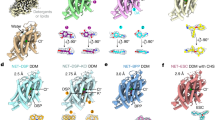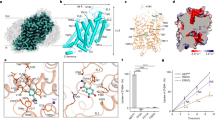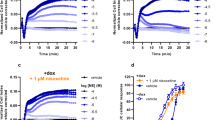Abstract
The relationship between the ability of repeated desipramine treatment to cause downregulation of the norepinephrine transporter (NET) and produce antidepressant-like effects on behavior was determined. Treatment of rats with 15 mg/kg per day desipramine reduced NET expression, measured by 3H-nisoxetine binding and SDS–PAGE/immunoblotting, in cerebral cortex and hippocampus and reduced the time of immobility in the forced-swim test. The antidepressant-like effect on forced-swim behavior was evident 2 days following discontinuation of desipramine treatment when plasma and brain levels of desipramine and its major metabolite desmethyldesipramine were not detectable. Reduced NET expression resulted in reduced norepinephrine uptake, measured in vitro, and increased noradrenergic neurotransmission, measured in vivo using microdialysis. Overall, the dose–response and time-of-recovery relationships for altered NET expression matched those for production of antidepressant-like effects on behavior. The importance of increased noradrenergic neurotransmission in the persistent antidepressant-like effect on behavior was confirmed by demonstrating that it was blocked by inhibition of catecholamine synthesis with α-methyl-p-tyrosine. The present results suggest an important role for NET regulation in the long-term behavioral effects of desipramine and are consistent with clinical data suggesting that enhanced noradrenergic neurotransmission is necessary, but not sufficient, for its antidepressant actions. Understanding the mechanisms underlying NET regulation in vivo may suggest novel targets for therapeutic intervention in the treatment of depression.
Similar content being viewed by others
Log in or create a free account to read this content
Gain free access to this article, as well as selected content from this journal and more on nature.com
or
References
Argenti D, D’Mello P (1994). The pharmacodynamics of desipramine and desmethyldesipramine in rats. J Pharmacol Exp Ther 270: 512–519.
Amano T, Aoki S, Setsuie R, Sakurai M, Wada K, Noda M (2006). Identification of a novel regulatory mechanism for norepinephrine transporter activity by the IP3 receptor. Eur J Pharmacol 536: 62–68.
Apparsundaram S, Galli A, DeFelice LJ, Hartzell HC, Blakely RD (1998a). Acute regulation of norepinephrine transporter: I. Protein kinase C-linked muscarinic receptors influence transporter capacity and transporter density in SK-N-SH cells. J Pharmacol Exp Ther 287: 733–743.
Apparsundaram S, Schroeter S, Giovanetti E, Blakely RD (1998b). Acute regulation of norepinephrine transport: II. PKC-modulated surface expression of human norepinephrine transporter proteins. J Pharmacol Exp Ther 287: 744–751.
Benmansour S, Altamirano AV, Jones DJ, Sanchez TA, Gould GG, Pardon MC et al (2004). Regulation of the norepinephrine transporter by chronic administration of antidepressants. Biol Psychiatry 55: 313–316.
Benmansour S, Cecchi M, Morilak DA, Gerhardt GA, Javors MA, Gould GG et al (1999). Effects of chronic antidepressant treatments on serotonin transporter function, density, and mRNA level. J Neurosci 19: 10494–10501.
Benmansour S, Owens WA, Cecchi M, Morilak DA, Frazer A (2002). Serotonin clearance in vivo is altered to a greater extent by antidepressant-induced downregulation of the serotonin transporter than by acute blockade of this transporter. J Neurosci 22: 6766–6772.
Bremner JD, Vythilingam M, Ng CK, Vermetten E, Nazeer A, Oren DA et al (2003). Regional brain metabolic correlates of alpha-methylparatyrosine-induced depressive symptoms: implications for the neural circuitry of depression. JAMA 289: 3125–3134.
Bryan-Lluka LJ, Paczkowski FA, Bonisch H (2001). Effects of short- and long-term exposure to c-AMP and c-GMP on the noradrenaline transporter. Neuropharmacology 40: 607–617.
Chen H, Pandey GN, Dwivedi Y (2006). Hippocampal cell proliferation regulation by repeated stress and antidepressants. Neuroreport 17: 863–867.
Charney DS (1998). Monoamine dysfunction and the pathophysiology and treatment of depression. J Clin Psychiatry 59: 11–14.
Cryan JF, Markou A, Lucki L (2002). Assessing antidepressant activity in rodents: recent developments and future needs. Trends Pharmacol Sci 23: 238–245.
Cryan JF, O’Leary OF, Jin SH, Friedland JC, Ouyang M, Hirsch BR et al (2004). Norepinephrine-deficient mice lack responses to antidepressant drugs, including selective serotonin reuptake inhibitors. Proc Natl Acad Sci (USA) 101: 8186–8191.
Drevets WC (2000). Functional anatomical abnormalities in limbic and prefrontal cortical structures in major depression. Prog Brain Res 126: 413–431.
Dunah AW, Standaert DG (2001). Dopamine D1 receptor-dependent trafficking of striatal NMDA glutamate receptors to the postsynaptic membrane. J Neurosci 21: 5546–5558.
Duncan GE, Paul IA, Breese GR (1993). Neuroanatomical differences in the rate of beta-adrenergic receptor adaptation after repeated treatment with imipramine. Psychopharmacol Bull 29: 401–407.
Garcia AS, Barrera G, Burke TF, Ma S, Hensler JG, Morilak DA (2004). Autoreceptor-mediated inhibition of norepinephrine release in rat medial prefrontal cortex is maintained after chronic desipramine treatment. J Neurochem 91: 683–693.
Frazer A (2000). Norepinephrine involvement in antidepressant action. J Clin Psychiatry S10: 25–30.
Frazer A, Benmansour S (2002). Delayed pharmacological effects of antidepressants. Mol Psychiatry 7: S23–S28.
Frazer A, Conway P (1984). Pharmacologic mechanisms of action of antidepressant. Psychiatr Clin North Am 7: 575–586.
Gould GG, Altamirano AV, Javors MA, Frazer A (2006). A comparison of the chronic treatment effects of venlafaxine and other antidepressants on serotonin and norepinephrine transporters. Biol Psychiatry 59: 408–414.
Jayanthi LD, Samuvel DJ, Blakely RD, Ramamoorthy S (2005). Evidence for biphasic effects of protein kinase C on serotonin transporter function, endocytosis, and phosphorylation. Mol Pharmacol 67: 2077–2087.
Jayanthi LD, Samuvel DJ, Ramamoorthy S (2004). Regulated internalization and phosphorylation of the native norepinephrine transporter in response to phorbol esters. Evidence for localization in lipid rafts and lipid raft-mediated internalization. J Biol Chem 279: 19315–19326.
Katz MM, Koslow SH, Frazer A (1996). Onset of antidepressant activity: reexamining the structure of depression and multiple actions of drugs. Depress Anxiety 4: 257–267.
Katz MM, Tekell JL, Bowden CL, Brannan S, Houston JP, Berman N et al (2004). Onset and early behavioral effects of pharmacologically different antidepressants and placebo in depression. Neuropsychopharmacology 29: 566–579.
Kitada Y, Miyauchi T, Kosasa T, Satoh S (1986). The significance of beta-adrenoceptor down regulation in the desipramine action in the forced swimming test. Naunyn Schmiedebergs Arch Pharmacol 333: 31–35.
Klimek V, Stockmeier C, Overholser J, Meltzer HY, Kalka S, Dilley G et al (1997). Reduced levels of norepinephrine transporters in the locus coeruleus in major depression. J Neurosci 17: 8451–8458.
Kodama M, Fujioka T, Duman RS (2004). Chronic olanzapine or fluoxetine administration increases cell proliferation in hippocampus and prefrontal cortex of adult rat. Biol Psychiatry 56: 570–580.
Lam RW, Tam EM, Grewal A, Yatham LN (2001). Effects of alpha-methyl-para-tyrosine-induced catecholamine depletion in patients with seasonal affective disorder in summer remission. Neuropsychopharmacology 25: S97–S101.
Lapiz MD, Bondi CO, Morilak DA (2007a). Chronic treatment with desipramine improves cognitive performance of rats in an attentional set-shifting test. Neuropsychopharmacology 32: 1000–1010.
Lapiz MD, Zhao Z, Bondi CO, O’Donnell JM, Morilak DA (2007b). Blockade of autoreceptor-mediated inhibition of norepinephrine release by atipamezole is maintained after chronic reuptake inhibition. Int J Neuropsychopharmacol 10: 827–833.
Lin JW, Wyszynski M, Madhavan R, Sealock R, Kim JU, Sheng M (1998). Yotiao, a novel protein of neuromuscular junction and brain that interacts with specific splice variants of NMDA receptor subunit NR1. J Neurosci 18: 2017–2027.
Mancinelli A, D’Aranno V, Stasi MA, Lecci A, Borsini F, Meli A (1991). Effect of enantiomers of propranolol on desipramine-induced anti-immobility in the forced swimming test in the rat. Pharmacol Res 23: 47–50.
Mandela P, Ordway GA (2006). The norepinephrine transporter and its regulation. J Neurochem 97: 310–333.
Millan MJ (2006). Multi-target strategies for the improved treatment of depressive states: conceptual foundations and neuronal substrates, drug discovery and therapeutic application. Pharmacol Ther 110: 135–370.
Miller HL, Delgado PL, Salomon RM, Berman R, Krystal JH, Heninger GR et al (1996a). Clinical and biochemical effects of catecholamine depletion on antidepressant-induced remission of depression. Arch Gen Psychiatry 53: 117–128.
Miller HL, Delgado PL, Salomon RM, Heninger GR, Charnery DS (1996b). Effects of alpha-methyl-para-tyrosine (AMPT) in drug-free depressed patients. Neuropsychopharmacology 14: 151–157.
Nelson JC, Mazure CM, Jatlow PI, Bowers Jr MB, Price LH (2004). Combining norepinephrine and serotonin reuptake inhibition mechanisms for treatment of depression: a double-blind, randomized study. Biol Psychiatry 56: 535–546.
Nibuya M, Nestler EJ, Duman RS (1996). Chronic antidepressant administration increases the expression of cAMP response element binding protein (CREB) in rat hippocampus. J Neurosci 16: 2365–2372.
O’Donnell JM (1990). Behavioral effects of beta adrenergic agonists and antidepressant drugs after down-regulation of beta-2 adrenergic receptors by clenbuterol. J Pharmacol Exp Ther 254: 147–157.
O’Donnell JM, Seiden LS (1984). Altered effects of desipramine on operant performance after 6-hydroxydopamine-induced depletion of brain dopamine or norepinephrine. J Pharmacol Exp Ther 229: 629–635.
Ordway GA, Gambarana C, Frazer A (1988). Quantitative autoradiography of central beta adrenoceptor subtypes: comparison of the effects of chronic treatment with desipramine or centrally administered l-isoproterenol. J Pharmacol Exp Ther 247: 379–389.
Ordway GA, Gambarana C, Tejani-Butt SM, Areso P, Hauptmann M, Frazer A (1991). Preferential reduction of binding of 125I-iodopindolol to beta-1 adrenoceptors in the amygdala of rat after antidepressant treatments. J Pharmacol Exp Ther 257: 681–690.
Ordway GA, Jia W, Li J, Zhu MY, Mandela P, Pan J (2005). Norepinephrine transporter function and desipramine: residual drug effects versus short-term regulation. J Neurosci Methods 143: 217–225.
Paxinos G, Watson C (1998). The Rat Brain in Stereotaxic Coordinates 4th edn. Academic Press: San Diego.
Porsolt RD, Le PM, Jalfre M (1977). Depression: a new animal model sensitive to antidepressant treatments. Nature 266: 730–732.
Sacchetti G, Bernini M, Gobbi M, Parini S, Pirona L, Mennini T et al (2001). Chronic treatment with desipramine facilitates its effect on extracellular noradrenaline in the rat hippocampus: studies on the role of presynaptic alpha2-adrenoceptors. Naunyn Schmiedebergs Arch Pharmacol 363: 66–72.
Sairanen M, Lucas G, Ernfors P, Castren M, Castren E (2005). Brain-derived neurotrophic factor and antidepressant drugs have different but coordinated effects on neuronal turnover, proliferation, and survival in the adult dentate gyrus. J Neurosci 25: 1089–1094.
Salomon RM, Miller HL, Delgado PL, Charney D (1993). The use of tryptophan depletion to evaluate central serotonin function in depression and other neuropsychiatric disorders. Int Clin Psychopharmacol S2: 41–46.
Santarelli L, Saxe M, Gross C, Surget A, Battaglia F, Dulawa S et al (2003). Requirement of hippocampal neurogenesis for the behavioral effects of antidepressants. Science 301: 805–809.
See RE, Adams-Curtis L, Chapman MA (1992). Assessment of dopamine release by in vivo microdialysis in the nucleus accumbens of rats following acute and chronic administration of desipramine. Ann NY Acad Sci 654: 522–524.
Smith PK, Krohn PI, Hermanson GT, Mallia AK, Gartner FH, Provenzano MD et al (1985). Measurement of protein using bicinchoninic acid. Anal Biochem 150: 76–85.
Smith TD, Kuczenski R, George-Fridedman K, Malley JD, Foote SL (2000). In vivo microdialysis assessment of extracellular serotonin and dopamine levels in awake monkeys during sustained fluoxetine administration. Synapse 38: 460–470.
Sung U, Blakely RD (2007). Calcium-dependent interactions of the human norepinephrine transporter with syntaxin 1A. Mol Cell Neurosci 34: 251–260.
Sung U, Jennings JL, Link AJ, Blakely RD (2005). Proteomic analysis of human norepinephrine transporter complexes reveals associations with protein phosphatase 2A anchoring subunit and 14-3-3 proteins. Biochem Biophys Res Commun 333: 671–678.
Szot P, Ashliegh EA, Kohen R, Petrie E, Dorsa DM, Veith R (1993). Norepinephrine transporter mRNA is elevated in the locus coeruleus following short- and long-term desipramine treatment. Brain Res 618: 308–312.
Tejani-Butt SM, Brunswick DJ, Frazer A (1990). 3H-nisoxetine: a new radioligand for norepinephrine uptake sites in brain. Eur J Pharmacol 191: 239–243.
Vizi ES, Zsilla G, Caron MG, Kiss JP (2004). Uptake and release of norepinephrine by serotonergic terminals in norepinephrine transporter knock-out mice: implications for the action of selective serotonin reuptake inhibitors. J Neurosci 24: 7888–7894.
Wyszynski M, Kharazia V, Shanghvi R, Rao A, Beggs AH, Craig AM et al (1998). Differential regional expression and ultrastructural localization of alpha -actinin-2, a putative NMDA receptor anchoring protein, in rat brain. J Neurosci 18: 1383–1392.
Weinshenker D, White SS, Javors MA, Palmiter RD, Szot P (2002). Regulation of norepinephrine transporter abundance by catecholamines and desipramine in vivo. Brain Res 946: 239–246.
Wong ML, Licinio J (2001). Research and treatment approaches to depression. Nat Rev Neurosci 2: 343–351.
Xu F, Gainetdinov RR, Wetsel WC, Jones SR, Bohn LM, Miller GW et al (2000). Mice lacking the norepinephrine transporter are supersensitive to psychostimulants. Nat Neurosci 3: 465–471.
Yamamoto H, Kagaya A, Kuroda Y, Mikuni M, Takahashi K (1990). Effect of antidepressants on the GTP binding sites in rat brain homogenate. Jpn J Psychiatry Neurol 44: 133–134.
Zhang HT, Zhao Y, Huang Y, Deng C, Hopper AT, De Vivo M et al (2006). Antidepressant-like effects of PDE4 inhibitors mediated by the high-affinity rolipram binding state (HARBS) of the phosphodiesterase-4 enzyme (PDE4) in rats. Psychopharmacology 186: 209–217.
Ziegler VE, Biggs JT, Rosen SH, Meyer DA, Preskorn SH (1978). Imipramine and desipramine plasma levels: relationship to dosage schedule and sampling time. J Clin Psychiatry 39: 660–663.
Zhu MY, Blakely RD, Apparsundaram S, Ordway GA (1998). Down-regulation of the human norepinephrine transporter in intact 293-hNET cells exposed to desipramine. J Neurochem 70: 1547–1555.
Zhu MY, Kim CH, Hwang DY, Baldessarini RJ, Kim KS (2002). Effects of desipramine treatment on norepinephrine transporter gene expression in the cultured SK-N-BE(2)M17 cells and rat brain tissue. J Neurochem 82: 146–153.
Zhu MY, Kyle PB, Hume AS, Ordway GA (2004). The persistent membrane retention of desipramine causes lasting inhibition of norepinephrine transporter function. Neurochem Res 29: 419–427.
Zhu MY, Ordway GA (1997). Down-regulation of norepinephrine transporters on PC12 cells by transporter inhibitors. J Neurochem 68: 134–141.
Zhu MY, Wang WP, Baldessarini RJ, Kim KS (2005). Effects of desipramine treatment on tyrosine hydroxylase gene expression in cultured neuroblastoma cells and rat brain tissue. Brain Res Mol Brain Res 133: 167–175.
Acknowledgements
We thank Drs Bernd Meibohm and Lisa Tang for advice and assistance on the measurement of plasma and brain levels of desipramine and desmethyldesipramine. This work was supported by research grants from the National Institute of Mental Health (MH051175, MH040694, and MH072672).
Author information
Authors and Affiliations
Corresponding author
Additional information
DISCLOSURE/CONFLICT OF INTEREST
JM O’Donnell and H-T Zhang have received research support from Memory Pharmaceuticals and Lundbeck Pharmaceuticals.
Z Zhao, A Baros, M Lapiz, C Bondi, and D Morilak declare no financial interests that could be perceived as constituting a potential conflict of interest.
Rights and permissions
About this article
Cite this article
Zhao, Z., Baros, A., Zhang, HT. et al. Norepinephrine Transporter Regulation Mediates the Long-Term Behavioral Effects of the Antidepressant Desipramine. Neuropsychopharmacol 33, 3190–3200 (2008). https://doi.org/10.1038/npp.2008.45
Received:
Revised:
Accepted:
Published:
Issue date:
DOI: https://doi.org/10.1038/npp.2008.45
Keywords
This article is cited by
-
Blunted Amphetamine-induced Reinforcing Behaviors and Transporter Downregulation in Knock-in Mice Carrying Alanine Mutations at Threonine-258 and Serine-259 of Norepinephrine Transporter
Journal of Molecular Neuroscience (2022)
-
Neurochemical binding profiles of novel indole and benzofuran MDMA analogues
Naunyn-Schmiedeberg's Archives of Pharmacology (2017)
-
Effects of desipramine treatment on stress-induced up-regulation of norepinephrine transporter expression in rat brains
Psychopharmacology (2015)
-
Changes in behavior and ultrasonic vocalizations during antidepressant treatment in the maternally separated Wistar-Kyoto rat model of depression
Metabolic Brain Disease (2013)
-
Anxiety- rather than depression-like behavior is associated with adult neurogenesis in a female mouse model of higher trait anxiety- and comorbid depression-like behavior
Translational Psychiatry (2012)



